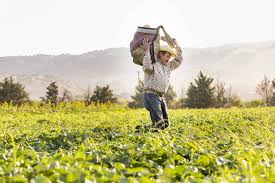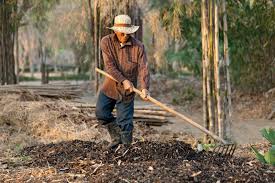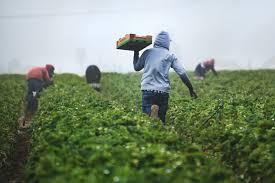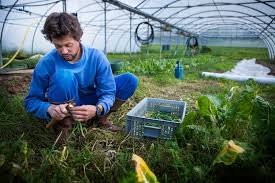Organic cropping systems are agricultural practices that emphasize sustainability, environmental stewardship, and health. These systems focus on cultivating crops without synthetic fertilizers, pesticides, or genetically modified organisms (GMOs), promoting biodiversity and soil health.
The essence of organic cropping lies in working with natural ecosystems rather than against them, which results in healthier soil, crops, and ultimately, food.
Practicing organic cropping systems can help restore and maintain ecological balance. These systems encourage the use of organic matter, such as compost and cover crops, to improve soil fertility and structure.
This approach not only enhances nutrient availability but also supports beneficial microorganisms that play a vital role in soil health.
By fostering a diverse ecosystem, organic cropping systems can reduce pest and disease pressure naturally, relying on biological controls rather than chemical interventions.
Transitioning to organic cropping requires a shift in mindset and methodology. Farmers must understand the unique characteristics of their soil and local environment to develop practices that will enhance productivity sustainably.
This may involve careful planning and a commitment to continuous learning, as organic farming is not merely a set of techniques but a holistic approach to agriculture.
Embracing organic cropping systems allows farmers to cultivate resilient crops, adapt to changing climatic conditions, and promote biodiversity.
To practice organic cropping systems effectively, one must consider various factors, including crop rotation, cover cropping, and integrated pest management (IPM).
Crop rotation involves alternating different crops in the same field over successive seasons to break pest cycles, improve soil health, and optimize nutrient use.
Cover cropping adds organic matter to the soil, suppresses weeds, and reduces erosion, contributing to a healthier farming system. IPM combines cultural, biological, and mechanical practices to manage pests sustainably, minimizing the need for chemical inputs.
In addition to improving soil and pest management, organic cropping systems contribute to environmental sustainability. By avoiding synthetic chemicals, these systems help protect water resources, reduce pollution, and promote biodiversity.
Organic farming practices encourage habitat preservation, supporting various wildlife species that contribute to pollination and natural pest control.
Furthermore, organic cropping systems align with growing consumer demand for healthier, sustainably produced food. As more people recognize the benefits of organic products, there is an increasing market for organic produce. Farmers who adopt these practices can tap into this lucrative market while contributing to environmental and public health.
Practicing organic cropping systems is a comprehensive approach that combines agricultural techniques, ecological principles, and consumer demand for sustainable food.
By focusing on soil health, biodiversity, and natural pest management, farmers can create productive and resilient cropping systems that benefit both the environment and their livelihoods.
The transition to organic cropping may require dedication and adaptation, but the long-term benefits make it a worthwhile endeavor for farmers seeking to contribute positively to the planet and society.
Understanding Soil Health in Organic Farming

1. Definition of Soil Health: Soil health refers to the ability of soil to function as a living ecosystem that sustains plants, animals, and humans, maintaining its productivity and environmental quality.
2. Importance of Organic Matter: High organic matter content improves soil structure, enhances moisture retention, and promotes microbial activity, which is crucial for nutrient cycling.
3. Microbial Diversity: A diverse microbial community in the soil is vital for breaking down organic matter, suppressing pests and diseases, and enhancing nutrient availability to crops.
4. Soil pH Management: Maintaining optimal pH levels is essential for nutrient availability; organic practices often involve adding amendments like lime or sulfur to adjust pH.
5. Nutrient Cycling: Organic farming relies on natural processes to cycle nutrients, using compost, cover crops, and crop residues to enhance fertility without synthetic fertilizers.
6. Soil Erosion Prevention: Healthy soils with good structure are less prone to erosion, helping to retain topsoil and nutrients, which is critical for sustainable farming.
Selecting Appropriate Crop Varieties
1. Local Adaptation: Choosing crop varieties that are well-adapted to local climate and soil conditions increases the chances of successful growth and high yields.
2. Disease Resistance: Selecting varieties with resistance to local pests and diseases reduces the need for chemical interventions and enhances overall farm resilience.
3. Nutritional Value: Prioritizing crops with high nutritional content can improve food quality and contribute to better health for consumers.
4. Yield Potential: Consideration of the potential yield of different varieties helps farmers select those that maximize productivity while aligning with market demands.
5. Growth Duration: Understanding the growth duration of varieties helps in planning planting and harvesting schedules to optimize labor and resources.
6. Market Preferences: Selecting varieties that meet market preferences, such as taste, color, and size, can improve profitability and reduce waste.
Crop Rotation: Principles and Benefits
1. Definition of Crop Rotation: Crop rotation involves alternating different types of crops in the same area across seasons to improve soil health and reduce pest and disease pressure.
2. Nutrient Management: Different crops have varying nutrient needs, and rotating them helps balance soil nutrients, preventing depletion and promoting overall soil fertility.
3. Pest and Disease Control: Rotating crops disrupts the life cycles of pests and pathogens, reducing their populations and the likelihood of outbreaks.
4. Weed Suppression: Different crops can outcompete weeds or reduce weed seed banks in the soil, making weed management more effective and less reliant on herbicides.
5. Soil Structure Improvement: Diverse root structures from different crops enhance soil aeration and water infiltration, leading to better soil structure and health.
6. Economic Resilience: By diversifying crop production, farmers can reduce financial risk and improve income stability, as different crops may thrive in varying conditions.
Read Also: Grapefruit Blossoms: Economic Importance, Uses and By-Products
Implementing Cover Crops for Soil Fertility

1. Definition of Cover Crops: Cover crops are plants grown primarily to improve soil health, enhance fertility, and prevent erosion, rather than for harvest.
2. Nutrient Fixation: Leguminous cover crops, such as clover and vetch, can fix atmospheric nitrogen into the soil, enriching it for subsequent crops.
3. Soil Structure Improvement: The root systems of cover crops help improve soil structure by creating channels for air and water movement, enhancing overall soil health.
4. Erosion Control: Cover crops reduce soil erosion by providing ground cover, protecting the soil from wind and water erosion during fallow periods.
5. Organic Matter Addition: When cover crops are terminated and incorporated into the soil, they add organic matter, which increases soil fertility and microbial activity.
6. Weed Suppression: Cover crops can outcompete weeds for light, water, and nutrients, reducing the need for herbicides and improving crop yields.
Natural Pest Management Techniques
1. Biological Control: Utilizing natural predators or parasites, such as ladybugs for aphids or parasitic wasps for caterpillars, helps manage pest populations without chemical pesticides.
2. Companion Planting: Planting certain crops together can deter pests; for example, marigolds can repel nematodes and other pests when planted alongside vegetables.
3. Habitat Enhancement: Creating habitats for beneficial insects, such as wildflower strips or hedgerows, can encourage pest predators and improve pest control.
4. Crop Rotation: Rotating crops disrupts pest life cycles and reduces populations, lowering the incidence of pest-related damage.
5. Cultural Practices: Adjusting planting dates, spacing, and methods can minimize pest pressure; for instance, early planting can help crops mature before pests become active.
6. Monitoring and Identification: Regular monitoring of pest populations and accurate identification allow for timely interventions and more effective pest management.
Utilizing Organic Fertilizers and Amendments
1. Definition of Organic Fertilizers: Organic fertilizers are derived from natural sources, such as compost, manure, and plant residues, enhancing soil fertility and health.
2. Nutrient Release: Organic fertilizers release nutrients slowly, providing a steady supply of essential nutrients over time, which is beneficial for plant growth.
3. Soil Microbial Activity: Organic amendments improve soil microbial populations, enhancing nutrient cycling and overall soil health.
4. Improving Soil Structure: Organic fertilizers enhance soil structure, increasing water retention and improving aeration, which are critical for healthy root development.
5. Source of Trace Elements: Organic fertilizers can provide essential trace elements that synthetic fertilizers may lack, promoting balanced nutrition for plants.
6. Environmental Benefits: Utilizing organic fertilizers reduces the risk of nutrient runoff into waterways, contributing to a healthier ecosystem.
Water Management in Organic Cropping
1. Importance of Water Management: Effective water management is crucial for optimizing plant growth, conserving resources, and preventing soil degradation in organic cropping systems.
2. Drip Irrigation Systems: Implementing drip irrigation delivers water directly to plant roots, reducing water waste and minimizing evaporation and runoff.
3. Rainwater Harvesting: Collecting and storing rainwater for irrigation helps reduce reliance on municipal water sources and promotes sustainable practices.
4. Soil Moisture Monitoring: Regularly monitoring soil moisture levels allows for more efficient water use and ensures crops receive adequate moisture without overwatering.
5. Mulching Techniques: Applying organic mulch conserves soil moisture, suppresses weeds, and enhances soil structure by reducing evaporation and regulating soil temperature.
6. Crop Selection and Placement: Choosing drought-resistant crops and placing them strategically based on water availability can optimize water use and improve overall crop resilience.
Strategies for Weed Control in Organic Systems
1. Cultural Practices: Implementing crop rotation and intercropping can disrupt weed life cycles, reducing their prevalence and competition for resources.
2. Mulching: Applying organic mulches, such as straw or wood chips, suppresses weed growth by blocking sunlight and retaining soil moisture.
3. Mechanical Weeding: Utilizing tools like hoes, cultivators, and flame weeders effectively removes weeds from the soil without relying on chemicals.
4. Cover Crops: Planting cover crops can outcompete weeds for light, nutrients, and space, helping to suppress weed populations.
5. Timely Tillage: Timing tillage operations to disturb the soil when weed seeds are germinating can reduce weed emergence while minimizing soil erosion.
6. Hand Weeding: Employing manual weeding methods allows for precise control of weeds, especially in small-scale organic operations where labor is available.
Read Also: 6 Medicinal Health Benefits Of Genista tinctoria (Dyer’s greenweed)
Harvesting and Post-Harvest Practices

1. Timing of Harvest: Monitoring crop maturity ensures optimal harvest times, improving yield quality and reducing post-harvest losses.
2. Harvesting Techniques: Using appropriate tools and techniques, such as sickles or knives for delicate crops, minimizes damage to plants and ensures a clean harvest.
3. Post-Harvest Handling: Proper handling techniques, including careful transportation and storage, prevent physical damage and spoilage of harvested produce.
4. Cleaning and Sorting: Cleaning crops of dirt and debris and sorting by quality before storage enhance marketability and shelf life.
5. Storage Conditions: Maintaining appropriate temperature and humidity levels during storage helps preserve freshness and extends shelf life.
6. Record Keeping: Documenting harvest and post-harvest processes aids in quality control and helps farmers improve future practices.
Certification and Standards for Organic Farming
1. Understanding Certification: Organic certification verifies that farming practices comply with established organic standards, assuring consumers of product integrity.
2. Regulatory Bodies: Familiarizing with local and international certifying agencies, such as USDA or EU standards, ensures compliance with relevant regulations.
3. Documentation: Keeping detailed records of farming practices, inputs used, and land management strategies is crucial for the certification process.
4. Transition Period: Recognizing that organic certification typically requires a transition period (often three years) during which conventional practices are phased out is important.
5. Annual Inspections: Being prepared for annual inspections by certifying agencies to verify compliance with organic standards is essential for maintaining certification.
6. Labeling Standards: Understanding labeling requirements for organic products helps ensure accurate marketing and compliance with consumer expectations.
Challenges and Solutions in Organic Cropping
1. Pest Management: Organic farmers often face challenges with pest control due to the limited availability of chemical options; implementing integrated pest management (IPM) strategies can mitigate this issue.
2. Weed Pressure: High weed pressure can reduce crop yields; utilizing cultural practices, mulching, and mechanical weeding can effectively control weeds in organic systems.
3. Soil Fertility: Maintaining soil fertility without synthetic fertilizers can be challenging; utilizing compost, cover crops, and organic amendments can enhance soil health.
4. Market Access: Limited access to markets for organic products can hinder profitability; forming cooperatives and participating in farmers’ markets can improve market access.
5. Knowledge Gaps: Lack of knowledge about organic practices can be a barrier; participating in workshops, extension programs, and collaborating with experienced organic farmers can enhance skills.
6. Weather Variability: Climate change and unpredictable weather can impact organic crops; implementing adaptive practices, such as diversified cropping systems, can improve resilience to climate impacts.
Do you have any questions, suggestions, or contributions? If so, please feel free to use the comment box below to share your thoughts. We also encourage you to kindly share this information with others who might benefit from it. Since we can’t reach everyone at once, we truly appreciate your help in spreading the word. Thank you so much for your support and for sharing!
Read Also: A Comprehensive Guide To Circular Economy Consulting

